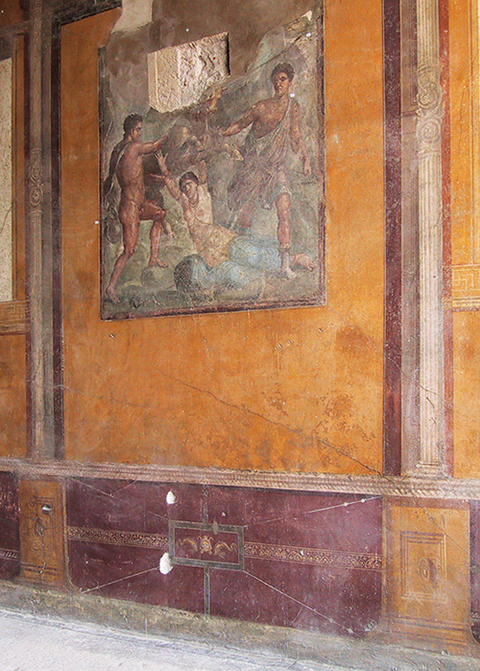 1>
1>In addition to examining and challenging some of the accusations of hedonistic complicity levelled against the wall-paintings, this chapter endeavours to unravel some of the complex psychological positions that emerge when concepts such as ‘dwelling’, ‘social interaction’ 'cultural production', and ‘palace’ come together. These mainly relate to human constructs such as domain, comfort, control, aspiration and luxury. More specifically ‘palace’ signifies the desire to create a dwelling that is significantly more than a roof over one’s head.
In addition to using the wall-paintings to socially position the house, social historians also used them to determine and even evaluate the aesthetic taste of the paterfamilias, the head of the Roman household. In order to do this the paintings had to be classified as ‘interior decoration’ devoid of symbolic meaning. Like the ‘invisible man’ the head of the household was made visible by his exterior wrappings - the décor within which he and his family once existed. On the surface this may seem a reasonable strategy for determining an occupant's socio-cultural identity. However, in reality it places the wall-paintings and their owners in an extremely crude conceptual cul-de-sac that is either determined by the writer’s aesthetic values, or it leaves them exposed to interpretations based on literary sources such as the Satyricon, or equally distorting polemical texts espousing the evils of acquiring excessive amounts of luxury. Elizabeth Bartman, for example, criticised Paul Zanker, one of the main exponents of the hedonistic palatial luxury thesis, for using his personal aesthetic values to evaluate Pompeian taste (Bartman 1990: 276). The validity of her criticism is examined in greater detail in the Case Study that follows the first part of this chapter.
The Trimalchio Effect
Popular films and academic texts on Roman luxury invariably evoke the image of the nouveau riche Trimalchio as a model for the archetypal debauched Roman freedman who is relentlessly engaged in the pursuit of luxury and self-gratification. The Satyricon, in which he plays a central role, is one of the few ancient texts to refer to domestically located wall-paintings and although it is a preposterous fictional satire it is never-the-less used to link wall-paintings to the pursuit of ostentatious luxury and as a means of determining and critiquing aesthetic values. The Casa dei Vettii in Pompeii is a case in point. This house has come to epitomise the extremes of both good and bad taste. Roger Ling described features within the house as…”splendid”… “having exquisite ornamental detail”….and being “especially fine”, whilst John Clarke associated the owner’s taste with that of Trimalchio’s, which in turn prompted Eleanor Leach to remind Clarke that Trimalchio was a fictional “caricature” (Ling 1991: 78); (Clarke 1991: 233-5); (Leach 2004: 309: n117).
Casa dei Vettii, Pompeii ( detail), oecus leading to a peristyle garden
|